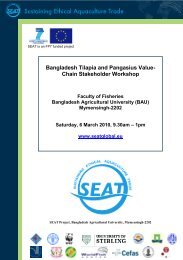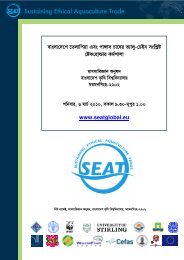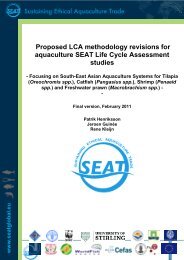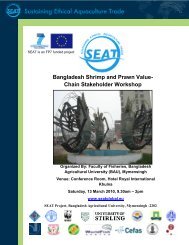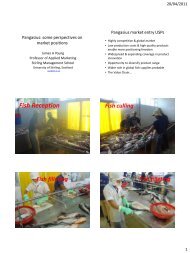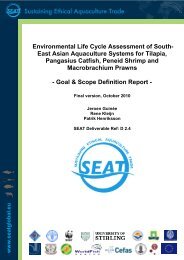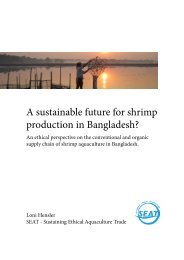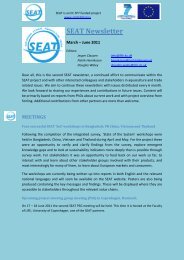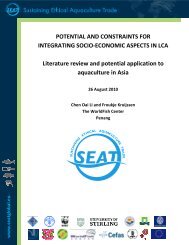D4.1 Review of Environmental Models - SEAT Global
D4.1 Review of Environmental Models - SEAT Global
D4.1 Review of Environmental Models - SEAT Global
You also want an ePaper? Increase the reach of your titles
YUMPU automatically turns print PDFs into web optimized ePapers that Google loves.
1.2.9 SIMILE<br />
(Pauley et al., 2000). It utilises a grid system and maps to model spatial dynamics as a series<br />
<strong>of</strong> box models (Ecopath, 2010).<br />
Simile is a system dynamics modelling package with the same “stocks and flows” objectorientated<br />
interface as programs such as STELLA, Powersim and Vensim (Ford, 2009). It was<br />
originally derived from a model known as “Agr<strong>of</strong>orrestry Modelling Environment”<br />
(Muetzelfeldt & Taylor, 1997). The Simile package incorporates system dynamics modelling<br />
with spatial modelling using grid reference (Muetzelfeldt et al, 2003)<br />
The Simulink package has been used in Quebec, Canada, to determine the carrying capacity<br />
<strong>of</strong> the Lagune de la grande-Entrée for suspended mussel culture (Grant et al,. 2007) the<br />
model is a simple set up which allows the user to determine the effects <strong>of</strong> stocking densities<br />
on the surrounding environment and enable an informed decision to be made as to whether<br />
the lagoon can accept the growth <strong>of</strong> aquaculture in the area or not. The model consisted <strong>of</strong><br />
five mass balance equations which included mussel mass growth, the rate <strong>of</strong> change in<br />
detrital matter concentration, rate <strong>of</strong> change in phytoplankton concentration, the rate <strong>of</strong><br />
change in zooplankton concentration and the rate <strong>of</strong> change in nitrate and ammonia<br />
concentration (Grant et al., 2007). In this example the model suggested that the lagoon was<br />
robust enough to take on more aquaculture after having the model validate and run through<br />
a sensitivity analysis. (Grant et al, 2007)<br />
1.2.10 Spreadsheet-based dynamic models<br />
Spreadsheets can produce both simple and complex models using in build numerical<br />
functions or programmed macros to manipulate data and perform multiple calculations<br />
(Ford, 2009). Macro codes are <strong>of</strong>ten available as proprietary add-ons to the spreadsheet<br />
s<strong>of</strong>tware. Spreadsheets are designed to produce answers to complex calculations mainly for<br />
a single time point but can be used repeated to reproduce a dynamic time set. However, if<br />
this is done within the confines <strong>of</strong> the workbooks it is both time consuming and results in<br />
the production <strong>of</strong> a large number <strong>of</strong> sheets with potentially hundreds <strong>of</strong> linked cells <strong>of</strong> data<br />
making the whole model cumbersome and difficult to understand (Ford, 1999).<br />
Spreadsheets do <strong>of</strong>fer a modelling framework which is flexible and can be easily used to<br />
build and test preliminary models, which can later be refined in modelling s<strong>of</strong>tware<br />
mentioned above or in native program code. It provides a clear and organised way <strong>of</strong><br />
showing calculations and their numerical results (Ford, 2009). The final spreadsheets can<br />
also be linked to other dynamic modelling packages to supplement spatial modelling using a<br />
grid search method for multiple parameters, such as Powersim (Vlachos et al., 2007)<br />
MS Excel is probably the most commonly used spreadsheet for complex calculations and<br />
modelling. It has the advantages <strong>of</strong> being almost universally used, so outputs are easily<br />
transferable, and it uses VBA as its macro script, which is a standard and widely used and<br />
understood. Spreadsheets are used for completely developed models or for formatting and<br />
storage <strong>of</strong> data for entry into other modelling packages, for example Vensim and ArcGIS (Yeh<br />
et al, 2006), and IDRISI (Perez et al, 2002). In the former case, the spreadsheet provided a<br />
bridge allowing the conversion <strong>of</strong> outputs from ArcGIS into a form suitable for use in Vensim<br />
for dynamic modelling <strong>of</strong> the Keelung watershed in Taiwan (Yeh et al, 2006). Spreadsheets<br />
Page 11



